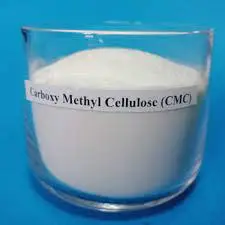IUPAC Name
2,3,4,5,6 - Pentahydroxyhexanal
Cas Number
9004-32-4
HS Code
3912.31.00
Formula
C8H16O8
Appearance
White or lightly yellow powder
Common Names
Carboxymethylcellulose, carmellose
Packaging
800 @ 25 kg Drums, 20MT
Brief Overview
Carboxymethyl cellulose, which is also known as CMC, is derived from cellulose by introducing a carboxymethyl group along the cellulose chain. The functional properties of carboxymethyl cellulose depend on the degree of substitution of the cellulose structure. This also allows the molecule to be hydrated, thus becoming soluble. The higher the degree of substitution, the more rapidly it dissolves.
Manufacturing Process
The CMC manufacturing process reaction stages can be divided into two steps: mercerization and etherification. The goal of mercerization is to produce alkali cellulose, whereas the etherification step produces CMC. Mercerization, like all cellulose ethers, begins with cellulose dissolution.
Mercerization is a process in which solvents are used to swell and dissolve the cellulose pulp, increasing the reactive surface and allowing NaOH to penetrate more easily. The swollen and dissolved cellulose is turned into alkali cellulose (or Na-cellulose) in an alkalization reaction when NaOH reacts with the exposed hydroxyl groups. The chemical reaction for mercerization is as bellow
C6H10O5C6H9O4 ∙ OH + NaOH → C6H10O5 ∙ C6H9O4 ∙ ONa + H2O
Etherification At around 50-70ºC, alkali cellulose from the mercerization stage reacts with added MCA in the presence of NaOH in the etherification stage. A hydroxyl group replaces hydrogen with a carboxymethyl group at the molecular level. This process is also known as carboxymethylation. When NaOH reacts with MCA, it produces unwanted byproducts such as reaction salts sodium glycolate and sodium chloride, both of which are considered impurities. As a result, the reaction yields technical grade CMC, which is refined later in the process if necessary.
Food Industry
Carboxymethyl cellulose is used as a viscosity modifier and thickener. The anionic nature of it interact with the positive charges found in protein in acidic conditions, thus stabilizing the low pH dairy beverage. It is used to stabilize emulsions in food product like ice cream to control meltdown, texture and protect against heat shock. Carboxymethyl cellulose is used to improve yield in baking by increasing gas bubble formations. It can control ice crystal growth in frozen desserts and soft-serve ice creams and improve mouth feel, body and texture, thus enhancing the quality of bakery items and frozen desserts. It is used in pet foods as a water binder, gravy thickener and extrusion aid.
Pharmaceutical Industry
It is used as a thickening agent in the pharmaceutical industry
Other applications
It is used in lubricants, toothpaste, laxatives, diet pills, water-based paints, detergents, textile sizing, and paper products.
